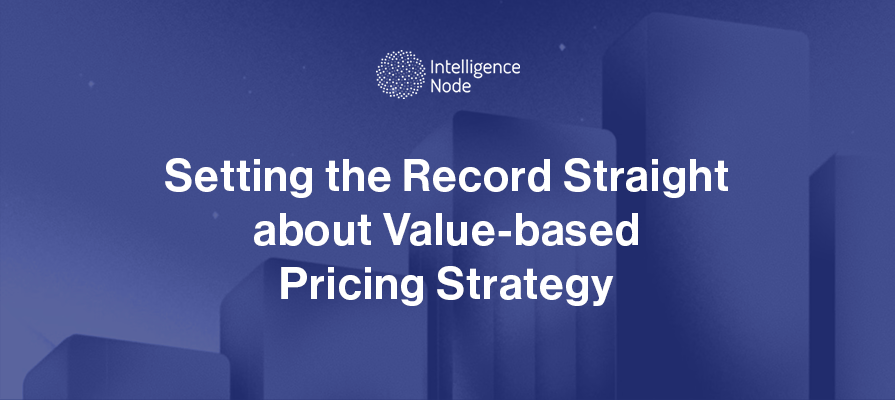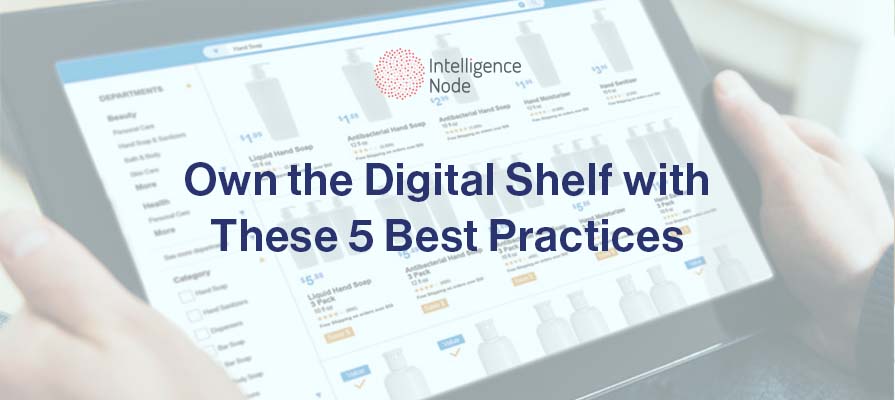Content Summary :
The Rise and Rise of Amazon
Amazon Pricing Model
How Sellers Price Items on Amazon
Establishing Prices for Your Products on Amazon
What is Intelligence Node’s Take on Dynamic Pricing for Amazon?
Winning the Buy Box on Amazon
Other Pricing Strategies for Success on Amazon
Conclusion The Retail Giant that Changed the eCommerce Landscape
Amazon is the leading e-retailer in the United States, with net sales amounting to close to 386 billion U.S. dollars in 2020. Every seller, new or old wants to sell on Amazon because of its huge, global customer base. It has become a household name in many countries and is synonymous to online shopping for most. But it didn’t just get here overnight. Amazon worked its way to the top by implementing sophisticated processes, advanced technology, always competitive Amazon pricing and customer centricity, and by slowly expanding to different geographies and diversifying its merchandise. It took customer centricity one step further by the launch of Amazon Prime, making shopping cheaper and more convenient for its loyal customers and increasing its popularity globally.
The key factors behind Amazon’s vast success is its dynamic pricing model, its promise to always offer the best prices to its customers, its convenient and fast delivery options, and the sheer magnitude and the variety of products it offers.
Although merchants can benefit a lot from selling their products on Amazon, the pricing can be challenging and slashing prices alone might not always work in your favor. Merchants need to understand that Amazon takes multiple factors into account along with competitive prices to rank them on top and feature them in the Buy Box. In this blog post, we will look at the key pricing methods Amazon sellers can employ to make the most of their listings on Amazon.
What is the Amazon Pricing Model?
Amazon’s pricing model revolves around offering the most competitive prices to shoppers. Which means, the prices don’t stay constant and can change even multiple times a day (Amazon dynamic pricing). Low prices ensure brand loyalty and retention and make it profitable for sellers using Amazon to sell their products and build a customer base.
The Buy Box is a cherry on top of Amazon’s pricing model that adds to the success of Amazon. While sellers are battling it out to appear on the Buy Box which will ensure more visibility and hence more sales, it also ensures that shoppers get offered the lowest possible prices for the same products. And even if sellers don’t make it to the Buy Box, they can still rank high based on the combination of product price as well as the shipping price that Amazon takes into account.
To add to the low prices, Amazon also wins customers with its convenience. With thousands of retailers selling products through Amazon, chances of running out of stock are very low, ensuring consumers always get the product they are looking for, variations of those products across different price points, and fast and easy delivery and returns.
How do Sellers Price Items on Amazon?
There are multiple ways for sellers to price their products on Amazon but the ultimate goal for any seller is to make more profitable sales through the platform. In most cases merchants set their prices in ways that win them the buy box but for private label brands and niche products it is more about appearing higher on search results than their competitors leading to better visibility and more conversions.
But it is not just all about pricing to win more sales. Amazon also looks at reviews and ratings, keywords and product descriptions, delivery and fulfillment, and product availability to rank you higher on search results or feature you on the buy box.
But as we are currently focusing on Amazon pricing, let’s look at its most popular pricing models and what factors you, as merchants and sellers, should consider before determining your pricing strategy and product prices:
Establishing Prices for Your Products on Amazon
Price is one of the most important factors in determining your success on the Amazon platform. Bear in mind that the competition is cut-throat and any slip up in pricing could cost you a huge amount of sales. That considered, the easiest way to determine prices is to first understand your financial and sales goals, your target audience, and your costs and overheads. Your prices need to be competitive while also making you profits. Identify the highest and lowest prices you can offer and then determine an average price that will gain you profits but also give you a competitive advantage. Once you know the price range for your product, a key strategy to employ on Amazon is the dynamic pricing strategy.
Dynamic Pricing Strategy
Shoppers today are well-informed, technologically occupied and known to compare prices of products before making a purchase. In fact many price matching tools like Camel Camel Camel and Krazy Coupon Lady are now available for consumers for this very purpose. This makes the Amazon pricing game even more complex and competitive, making dynamic pricing a necessity to stay in the competition and convert these comparison shoppers into buyers.
Amazon is known for its dynamic pricing or what is also known as repricing strategy. In this strategy, the prices of products don’t remain constant but change often depending on competitor prices, demand and supply, and market trends. With the large number of buyers and sellers on the Amazon market, dynamic pricing becomes complex and prices can change multiple times a day depending on how certain products are performing that day. Amazon reviews prices of millions of its products every two minutes so if you don’t opt for repricing, chances are you will be left behind in the race to win consumers.
With a marketplace as huge as Amazon, every product has multiple competitors for consumers to choose from and compare prices against. And chances of consumers buying a higher priced product in the presence of a lower priced similar or identical product are bleak. By employing dynamic repricing strategy, sellers can ensure that they are in the best position to offer competitive prices and win new customers. In simple terms, repricing or dynamic pricing is a strategy where you adjust prices to undercut your competition. You can decide the highest and lowest price you are willing to offer for a product while protecting your margins and adjust your prices within this threshold to match or beat competitor prices. There are three different ways you can reprice your products on Amazon
Manual Repricing
In the manual repricing method, you can choose to undercut competition by repricing products manually through Amazon Seller Central or other platforms in case you are selling through third-party sellers. This method is grueling and time consuming and will only work if you have a few products listed. It would also require you to constantly monitor competitor price movements to be able to adjust your prices in time.
Automated Rule-based Repricing
Automated repricing eliminates the need for manually reviewing prices and is a better, more streamlined way of repricing products to get a competitive advantage. With automated repricer tools, you can pre-configure rules like maximum and minimum prices, select products that you want, select the competition you want to track, etc. and let the repricing tool automatically update your prices for maximum returns. There are numerous free and paid repricing tools available in the market to choose from. In fact, Amazon too has its own repricing tool called ‘Automate Pricing’ which can be used by first-party Amazon sellers for free. Although a great option, Automate Pricing comes with its own cons.
Try our AI-powered competitor price monitoring software for optimizing pricing strategy on Amazon, Walmart and more. Learn More.
Algorithmic Repricing
Algorithmic repricing is the most sophisticated form of repricing tool available in the market. This type of repricing tool uses self-learning algorithms to reprice products. It doesn’t just lower prices or match prices with competitors but considers multiple factors while determining a winning price for a product – which could often be above the lowest price but still win the buy box. Although a great solution, algorithmic repricing tools are expensive and would make sense only for established sellers with a large inventory on Amazon.
What is Intelligence Node’s Take on Dynamic Pricing for Amazon?
Intelligence Node strongly believes that dynamic pricing is a highly effective pricing strategy on and off Amazon in today’s age of comparison shoppers. With ever expanding competition and its access to newer and better pricing tools, the only way ahead to thrive in the eCommerce arena is by optimizing prices in line with competitors to convert today’s price-sensitive shoppers and win market share. Dynamic pricing does not have to mean ‘always low pricing’ or cutting into your margins to stay competitive. A sustainable, scalable dynamic pricing strategy is the one which leverages sophisticated, Intuitive, and advanced technology like Intelligence Node’s dynamic pricing solution to take advantage of pricing and assortment gaps left by competitors and optimize prices with speed and precision to not only convert shoppers but also protect your margins and improve your profitability.
Winning the Buy Box on Amazon
Winning the Buy Box on Amazon is the end goal for most successful sellers selling on the platform. But it is not easy. When it comes to the Buy Box, low prices are not the only consideration. Although low prices are important to win the Buy Box, other factors also play a key role. Below are some methods you can employ to improve your chances of winning the Buy Box:
- Reduce your shipping time to as low as possible and definitely under 14 days
- Improve your product reviews and ratings by asking your customers to rate your products
- Do a quality check of your products to reduce returns and replacements to a minimum
- Incorporate the right keywords, adequate information, and images in your product descriptions to minimize cancellations
- Products fulfilled by Amazon (FBA) have a higher chance of getting featured due to the fast and assured delivery timeline, although this hasn’t been openly accepted by Amazon

Other Amazon Pricing Strategies to Build Your Brand
Premium Pricing
You don’t have to always lower your prices to be successful on Amazon. If you are selling a premium product, and have a big brand attached to you, you can implement a premium pricing strategy where you offer higher prices than those of your competitors. But this does not always work on Amazon as consumers are often not brand conscious and might opt for low prices over brand loyalty forcing many sellers to offer discounts and offers on their premium products.
Penetration Pricing
Penetration pricing is ideal for sellers or brands just starting out with new products and want to generate more interest around the product. In this strategy, merchants first lower their prices, often foregoing their profit margins to appear on the top of search results and increase interest and sales. And once they have established a good consumer base, they increase their prices.
Cost-plus Pricing
This is one of the basic most pricing strategies, where sellers add a fixed percentage or a markup to the cost of the product to determine a selling price that could give them a desired rate of return. Although a simple strategy, it is often difficult for sellers to determine the exact costs they are incurring behind a product, especially marketing costs which may skew the return rates they are expecting.
Value-based Pricing
Value-based pricing doesn’t stick to the usual norms of pricing that are often determined looking at historic pricing trends, costs, and competitor prices. In this type of strategy, the seller establishes prices based on the perceived value the products generate for consumers and the willingness to pay from their end. It makes sense for established brands with high brand value or for private-label brands that offer unique products and want to establish and differentiate themselves in the market.
Bottom Line
There is no one formula for success when it comes to pricing your products on Amazon. Sellers need to be agile, informed, and competitive with their prices and constantly evaluate what is working for them. Due to the highly competitive atmosphere and complex and sophisticated dynamic pricing algorithms used by Amazon, retailers and sellers need to invest in advanced technology and automated pricing solutions to stay ahead of competition. It is also important to review and optimize your listing, delivery and returns, and monitor your product quality to make the most of the marketplace and win the Amazon pricing war.
If you found this useful and you’d like to learn how to take your pricing strategy to the next level, we invite you to download our free 20 secrets to designing the best pricing strategy eBook. Click below to take advantage of this opportunity.
20 Secrets To Designing The Best Pricing Strategy



